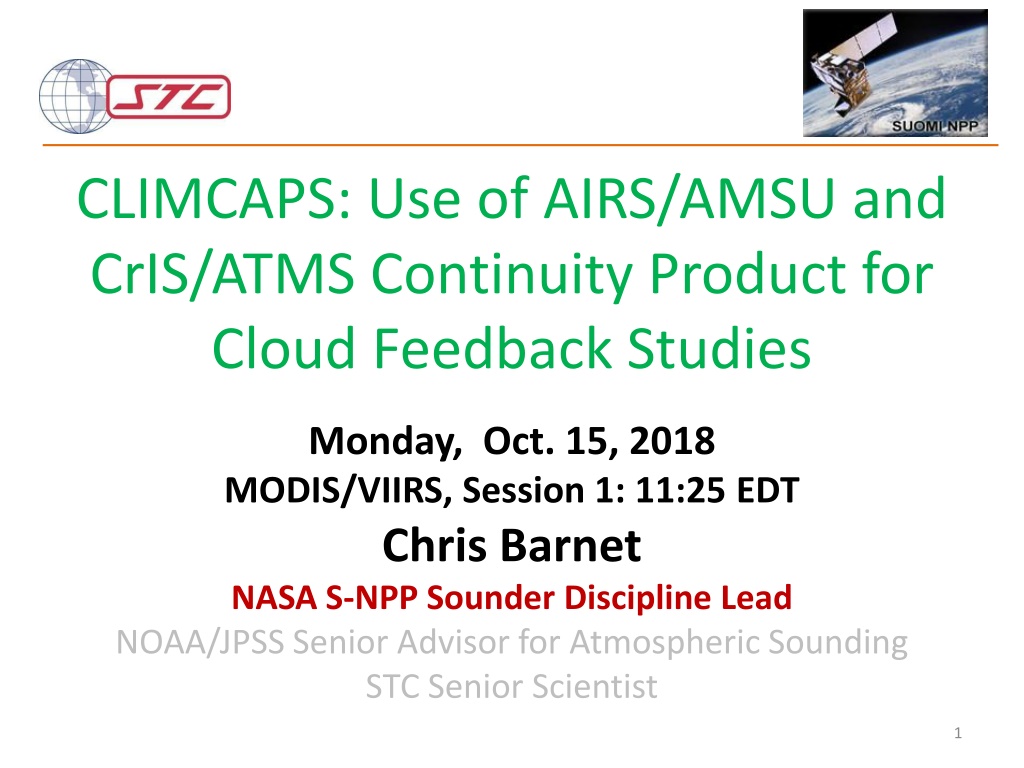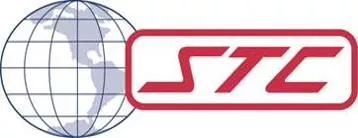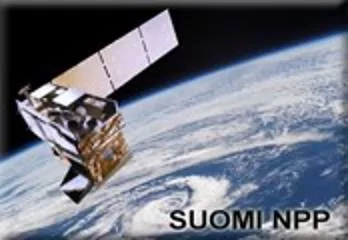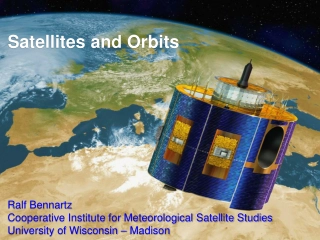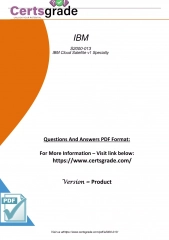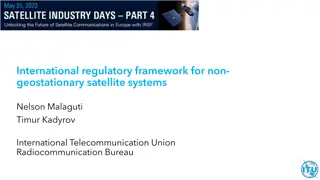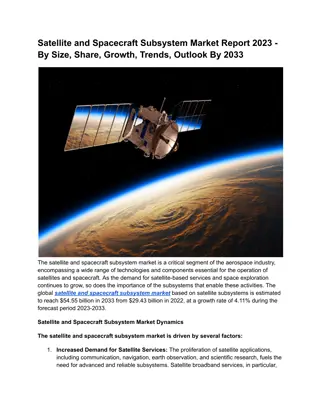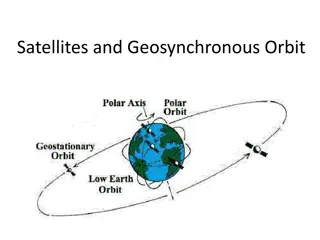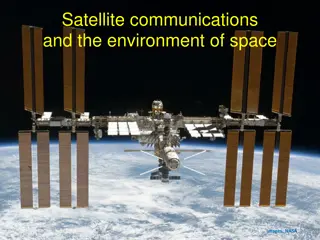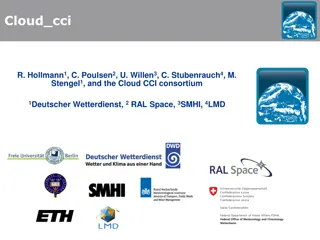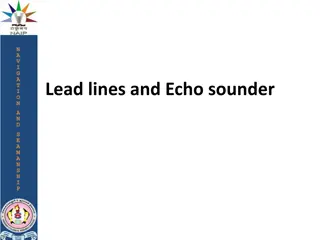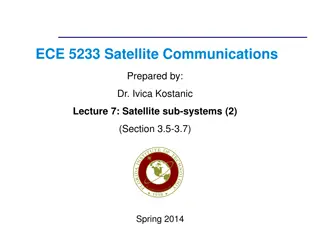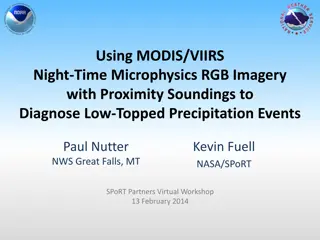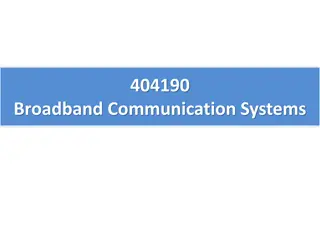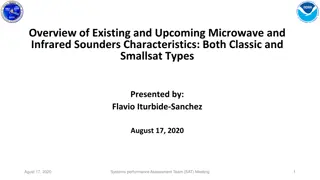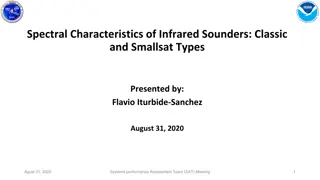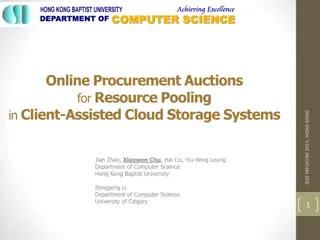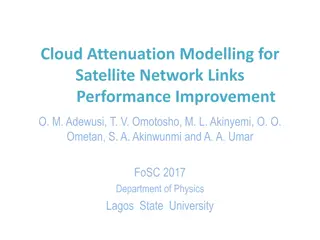Cloud Feedback Studies with Satellite Sounders
Utilizing continuity products from satellite sounders for cloud feedback studies across different operational thermal sounder suites to address needs of weather, climate, and composition monitoring communities. Focus on building long-term records and supporting real-time applications.
Download Presentation

Please find below an Image/Link to download the presentation.
The content on the website is provided AS IS for your information and personal use only. It may not be sold, licensed, or shared on other websites without obtaining consent from the author. Download presentation by click this link. If you encounter any issues during the download, it is possible that the publisher has removed the file from their server.
E N D
Presentation Transcript
CLIMCAPS: Use of AIRS/AMSU and CrIS/ATMS Continuity Product for Cloud Feedback Studies Monday, Oct. 15, 2018 MODIS/VIIRS, Session 1: 11:25 EDT Chris Barnet NASA S-NPP Sounder Discipline Lead NOAA/JPSS Senior Advisor for Atmospheric Sounding STC Senior Scientist 1
Creating a hyperspectral sounding continuity product We have 5 operational thermal sounder suites at this time Satellite Instruments Overpass Launch dates Aqua AIRS, AMSU 1:30 2002 Metop IASI, AMSU, MHS 9:30 2008, 2012, S-NPP, JPSS CrIS, ATMS 1:30 2011, 2017, There are numerous differences in these sounding suites Instruments are different Spectra resolution, sampling and noise Spatial sampling Degradation over time Algorithm differences NOAA algorithms became operational ~1 year after launch and have asynchronous maintenance schedules (e.g., training datasets are different) 9:30/1:30 orbits co-location w/ insitu is different (affects regression training and makes validation more difficult) Sensitivity to a-priori assumptions Sensitivity to meteorology (e.g., clouds at 9:30 vs 1:30 am/pm) Sensitivity to seasonal and climate changes (e.g., 8% increase in CO2, 2002-2017) Continuity was not the primary design criteria of the modern satellite sounding suite 2
Example of retrieval products (AIRS v.5 & 6 products are shown) Temperature Profiles Water Vapor Profiles Clouds Ozone CO SO2 Dust Methane CO2 3 3
We are attempting to meet the needs of 3 communities WEATHER Extreme events Risk - Commercial (Air Traffic, Energy) CLIMATE Processes Feedbacks Long-term trends COMPOSITION Monitor GHG s Air Quality 4
What are the areas of our current sounding research? NOAA-Unique Combined Atmospheric Processing System (NUCAPS) is supporting real-time weather and air quality applications (Metop 9:30 and S-NPP/JPSS 1:30 orbits). Air traffic safety. Pre-convective forecasting Wildfire management and air quality. Hurricane forecasting. Ozone recovery and use of ozone at STE indicator. The NASA Continuity product will focus on developing a long- term (2002-2040 s) record for Aqua/AIRS+AMSU and S- NPP/JPSS CrIS+ATMS Study how to build and document continuity records. Transparent, instrument agnostic approaches. Choose the appropriate a-priori for NASA applications. Create a baseline global product suite for EOS-era Communicate the strengths and caveats of the product 5
CLIMCAPS retains many components of the AIRS Methodology Employs cloud clearing Uses spatial information to correct for clouds Allows other state components (SST/LST, T(p), q(p), ( ), O3(p), CO(p), CO2, CH4, SO2, HNO3, N2O etc.) to be derived independently of clouds from spectral information A-priori used for cloud clearing is extremely important. Iteration of cloud clearing causes biases and confounds error characterization CLIMCAPS does not iterate cloud clearing Uses all space sounding assets Microwave radiances used for both for T(p) & q(p) information content and quality control Imager data is implicitly used via IR emissivity a-priori Retains the embedded information content (IC) analysis. Maximizes the weight of observations when IC is high Enables diverging from Merra-2 when necessary. 6
CLIMCAPS differs in the choice of a-priori for T, q, O3 Concern Statistical Model Re-analysis model zero Weight of obs is extremely small w.r.t. 6 hour window and all other instruments. Satellite data is used twice YES: All channels are used in NN and regressions. Subset of the same exact channels are re-used. Vertical sub-structure Derived from ECMWF statistics and only our obs. The a-priori contribution in the solution cannot be quantified. Derived from ensemble of many instruments and model dynamics. Contribution is partitioned via error propagation, dXdXT Latency Zero it is a static training Re-analysis: ~1 month GMAO FP: ~4 to 7 hours Spatial consistency Clouds and other signals cause spatial speckle that can induce large gradients at 100 km scale. Constrained by model dynamics (including thermal wind) and is spatially consistent. Temporal consistency (NOTE NN and regressions are trained from specific instruments within specific year(s).) Non-graceful response to instrument changes (e.g. , degradation, AIRS/CrIS transition) and state changes (climate, volcanoes, or anything outside the domain of its training) Stated goal is to mitigate obs. discontinuities. Can have artifacts due to instrument changes: O3: MLS in 10/2004; T/q: Metop 2009, 2013, S-NPP 2012, etc. 7
CLIMCAPS differs from AIRS Science Team and NUCAPS For 20+ years the sounder community has attempted to make a model-independent system. NUCAPS and AIRS v.6 use statistical models as the a-priori. CLIMCAPS uses Merra-2 reanalysis as a-priori for T(p) and q(p). Hypothesis: the statistical step in AIRS Science Team methodology does not provide a stable or well characterized a-priori for continuity. Merra-2 is a data driven system, does an incredible job with T(p). Retrieval can benefit from the stability provided by the reanalysis. For water vapor, hyperspectral infrared information content (IC) is high departs strongly from the re-analysis. CLIMCAPS uses the Combined ASTER & MODIS Emissivity over Land (CAMEL) as a-priori over land CAMEL database has scene dependent uncertainties Effectively brings in imager IC and high spectral resolution lab. data Significant improvements in the estimate of geophysical errors and their propagation through the retrieval process. 8
What about cloud products? We use the clear state (derived from microwave plus IR cloud cleared radiances) to derive cloud parameters from the single IR FOV s. Solve for two cloud top pressures and effective cloud fraction. Cloud cleared parameters and radiances . In CLIMCAPS the cloud clearing is more stable due to the stability of Merra-2 s clear state Post-process algorithms solve for cloud microphysical products. Single-FOV cloud microphysical approaches need to partition errors between clouds and the clear state. Errors in cloud forward models are still large. Minimization of residuals force these errors into the clear state products need to partition the errors. They also tend to use forecast models as their a-priori. We have multiple approaches for single FOV retrievals and these will be inter-compared to CLIMCAPS One funded by TASNPP has climatological a-priori (Xiu Lu, LaRC) 9
Applications we are targeting for the NASA continuity product. Topic Potential applications for thermal sounding products Fingerprinting (e.g., Santer 2018 Science, Pierrehumbert 2011 Phys. Today) Improved stratosphere/troposphere allows better separate of O3 hole from GHG s, N.H./S.H. gradients, polar amplification (downwelling thermal), Arctic moisture budget (Boisvert 2015 JGR) PBL (Fetzer 2004 GRL, Hoogewind 2017 J.Clim) Capping layer inversions, convection and stability. Most important for a thermal sounder is knowledge of when we have skill (i.e., averaging kernels). UTH, double ITCZ (Tian 2015 GRL), ENSO, MJO Stable and seasonally consistent T(p) will stabilize cloud clearing and q(p). Departures from Merra-2 will be more valuable than a derived state. Ozone Ozone hole; Intrusions and mid-trop O3 (Langford 2018 Atmos. Env); LS O3 trends (Ball 2018 ACP, Wargan 2018 GRL); CO/O3 ratio (Anderson 2016 Nat.Comm) Carbon Dioxide (CO2) Contribute to discussion of seasonal cycle amplitude (Barnes 2016 JGR), clear bias of OCO (Corbin 2008 JGR)., and stratospheric/troposphere CO2 gradient. (Separability of T/CO2 is improved with use of Merra-2 and AMSU/ATMS. Carbon Monoxide Long-term trends of CO (Worden 2013 ACP). Impact on OH (Gaubert 2017 GRL), Seasonal cycle (Park 2015 JGR) and CO/CO2 emission factors (Wang 2009 ACP) Methane (CH4) Monitoring of Amazon CH4 (Bloom 2016 ACP), Changes to Arctic emissions (Shakhova 2010 Science, Thornton 2016 GRL) Other trace gases Nitric Acid, Nitrous Oxide, Sulfur Dioxide, Isoprene, PAN, Acetylene, Methanol, etc all benefit from stable cloud clearing and upstream derived T(p), q(p), etc. 10
What about trends? Any trend in temperature in the a-priori will leave an imprint on the final thermal sounder product trend. Infrared has cross-talk between CO2 and T has been mitigated within CLIMCAPS (use of microwave, CO2 is solved for) Uncorrected, a 3 ppm change in CO2 will cause ~0.1 K in T(p) Statistical operators extrapolate trends from their training Induces a tendency to under-estimate trends. CLIMCAPS has been optimized to move away from a-priori Error estimates quantify IC added by sounder observations. Measurements will depart if AIRS or CrIS disagrees with Merra. TASNPP funded investigation of the derivation of trends from radiance differences (PI, Larrabee Strow) Simplifies the a-priori assumptions. Does not require solving for the full atmospheric state. 11
xCAPS is both an R2O and an O2R engine NUCAPS is based on AIRS Science Team (AST) methodology (version 5.9) and leverages a NASA research investment to support NOAA operations (R2O) NUCAPS-Metop has been operational since 2008 2008 to present Metop-A/IASI+AMSU+MHS + AVHRR 2012 to present Metop-B/IASI+AMSU+MHS 2/2013 to present, NUCAPS/S-NPP operational 7/2018 to present, NUCAPS/NOAA-20 operational (in DB) NUCAPS is fully capable of running AIRS+AMSU (but doesn t) NUCAPS has many operational users (T, q, O3, CO, and CH4) CLIMCAPS leverages NUCAPS & AST development (O2R) Continuity benefits diurnal Metop/NOAA-2x continuity CLIMCAPS has benefited from NUCAPS O2R investment NUCAPS can benefit from CLIMCAPS R2O investment 12
Choosing the cross-over point for Aqua to S-NPP Nominal or Full spectral resolution (NSR or FSR) Dec. 4, 2014 S-NPP/CrIS was put into FSR mode Nov. 2, 2015 S-NPP/CrIS FSR extended spectral mode Transition from AMSU+HSB to ATMS Aqua/AMSU Chl.7 has never been used Aqua/HSB was lost on Feb. 5, 2003 Aqua/AMSU degradation: Chl.4 (2007) and Chl.5 (2009-2011) Aqua/AMSU Chl.1 and 2 lost in 10/2016 ATMS scan reversals: began 7/14/15 (1/day), 8/9/16 (2x/orbit) Recommendation (based on discussions w/ L. Strow): Use AIRS+AMSU from 9/1/2002 to 8/31/2016 Use pristine AIRS channels that were well behaved Use AMSU 1, 2, 3, 6, 8, 9, 10, 11, 12, 13, 14, 15 Use S-NPP CrIS.FSR+ATMS from 9/1/2016 to 8/31/2018 12/10/2015-9/31/2016 overlap periods of Aqua/S-NPP Use NOAA-20 CrIS.FSR+ATMS from 9/1/2018 to Adequate overlap periods of S-NPP and NOAA-20 exist 13
Choosing the cross-over points for Aqua, S-NPP, and beyond S-NPP NOAA-20 NOAA-21 NOAA-22 NOAA-23 Aqua 14
How we plan to organize the sounding community Aqua/AIRS/AMSU is a project. AIRS Version.6 used a neural network a-priori S-NPP/NOAA-20 is a ROSES competed SIPS. With the Terra-Aqua-Suomi-NPP (TASNPP) selection these two worlds have been intertwined Joao Teixeira is the AIRS Project Lead Bryan Baum is the S-NPP Science Team Lead Chris Barnet is the S-NPP Sounder Discipline Lead We are now working towards a common goal of producing a EOS/S-NPP/JPSS continuity product. AIRS v.6.x will be maintained for use by science community. AIRS Science Team is evaluating CLIMCAPS as a candidate for Version.7. We are working towards having a GLOBAL baseline (CLIMCAPS) sounding product begin production at GES- DSIC by Oct. 2019 for Aqua, S-NPP, and NOAA-20 15
CLIMCAPS supports building a continuity dataset NOW Provide an archive of these measurements as a baseline for the future. Reasonable mitigation of instrument artifacts. Characterization with error covariance propagation and averaging kernels. Full suite of trace gases (O3(p), CO(p), CO2, CH4, SO2, HNO3, N2O). Build a long-term record so that TASNPP researchers can: Use the record for understanding climate processes and change. Document our best understanding of the information content. 9/2002-8/2016 AIRS + AMSU 9/2016-8/2035 CrIS-FSR + ATMS 1:30 am/pm using Aqua, S-NPP, NOAA-20 to 23 With sufficient overlap period of 2012-present Future work (next ROSES cycle?). Reprocessing using a Common Hyperspectral InfraRed Product (CHIRP) radiance dataset (transform AIRS, IASI, CrIS to common spectrum). Create a Metop long-term dataset: 2008 to 2040 s. Metop-A, -B, -C at 9:30 am/pm with IASI, AMSU, MHS. Follow-on (EPS-SG/IASI-NG) has been approved for 2021-2040. 16
Questions? 1. CLIMCAPS is a NASA continuity product system CLIMCAPS uses Merra-2 as a-priori for T(p) and q(p), CAMEL for ( ), static climatologies for trace gases. CLIMCAPS retrieves soundings in clear and partly cloudy scenes. CLIMCAPS has diurnal, seasonal and inter-annual and inter-satellite stability. CLIMCAPS propagates partitions a- priori and retrieval error estimates. CLIMCAPS is designed to support community needs. 7. So . How can CLIMCAPS support your research? 2. 3. 4. 5. 6. 17
Recent Terra-Aqua-S-NPP ROSES Cycle: 2018-2021 The TASNPP ROSES solicitation focused primarily on the continuity of the EOS mission. In addition, the solicitation cited Improvements to estimates of information content (e.g. error covariance matrix and averaging kernels). Improvements in the boundary layer. All data products must be focused on an application that can be justified as meeting NASA s applied science goals or a unique unmet operational data need that fits within the NASA program objectives and mission. For Suomi NPP, to prevent duplication of efforts pursued by NOAA, NASA will only support the upgrade, refresh and operation and maintenance of EOS Continuity algorithms and supporting systems. ROSES A.37 solicitation p.9-10. The Panel Review selected CLIMCAPS as the core algorithm. Numerous science applications that will be dependent on the upstream level-1 or level-2 products were selected. 18
Summary of the Algorithms Selected by the ROSES S-NPP Panel in 2018 PI, first name affiliatio n PI, last name instruments Aqua AIRS/AMSU & S-NPP and NOAA-20 CrIS/ATMS CrIS Level-1 summary of topic Continuity products for T(p), q(p), O3(p), other trace gases, surface and cloud top pressure and fraction. CrIS Single FOV NH3 Product Barnet Cady-Pereira Chris Karen STC AER Elsaesser Henze Gregory Daven ColumbiaAIRS Level-2 T/q at high spatial resolution U.Colo. CrIS NH3 product AIRS, CrIS Level-1 CERES, CrIS, Merra(T,q) JPL AMSU, ATMS Level.1 AIRS/AMSU Level.1 CrIS/ATMS Level.1 MIT/LL AIRS, CrIS, Level.1 JPL CrIS Level.1 Convective transition in storms. NH3 Inversion Model Huang Lambrigtsen Xianglei Bjorn U.Mich. cloud radiative effect ATMS Level-1 and Level-2 T, q S-FOV T,q,trace gas, surf, cloud CLARREO Climate Fingerprint NN L2 alg tailored for PBL Single FOV PAN Product Radiance DA: cloudy and cloud cleared targeted obs study dust correction within radiance DA H2O,O3 winds Radiative kernels to quantify CMIP6 fluxes Climate trends derived from delta radiances. cloud feedback CMIP5/6, compare w/ Merra Liu Milstein Payne Xu Adam Vivienne LaRC Reale Ruston Santek Soden Strow Tan Tian Oreste Benjamin David Brian Larrabee Ivy Baijun USRA NRL U.Wisc U.Miami AIRS, CERES, MODIS UMBC AIRS, CrIS, IASI UMBC MODIS, AIRS, CERES, AMSR JPL AIRS/AMSU MODIS, AMSE-R, CloudSat, CALIPSO, OMI, AIRS, IASI AIRS, CrIS Level.1 and CCR's AIRS, CrIS, CALIOP, MODIS, MISR AIRS, CrIS Dual Regress (q, O3) Wilcox Eric DRI study of radiative heating by black carbon Worden Helen UCAR MOPITT, CrIS Single FOV Carbon Monoxide retrieval product 19
Simplified Flow Diagram of the NUCAPS Algorithm Climatological First Guess for all products IR Physical CO(p) IR+MW Physical Ts, ( ), ( ) Microwave Physical for T(p), q(p), LIQ(p), (f) IR Physical HNO3(p) IR+MW Physical T(p) IR Physical CH4(p) IR+MW Physical q(p) Initial Cloud Clearing, j, Rccr IR Physical CO2(p) IR Physical O3(p) MIT Statistical Operator for Ts, ( ), T(p), q(p) IR Physical N2O(p) Final Cloud Clearing, j, Rccr RET IR Physical Ts, ( ), ( ) IR+MW Physical Ts, ( ), ( ) Note: Repeated physical steps always use same startup for that product, but it uses products and error estimates from other steps. FG CCR Improved Cloud Clearing, j, Rccr IR+MW Physical T(p)
Simplified Flow Diagram of the CLIMCAPS Algorithm MERRA-2 (T, q, O3), CAMEL/Masuda ( ( )), climatologies (trace gases) IR+MW Physical Ts, ( ), ( ) IR Physical CH4(p) IR Physical CO2(p) IR+MW Physical T(p) Microwave-only Physical for T(p), q(p), LIQ(p), (f) IR Physical N2O(p) IR+MW Physical q(p) IR Physical O3(p) LIQ(p), (f) Final Cloud Clearing, j, Rccr IR Physical CO(p) MIT + RET IR Physical HNO3(p) CCR Note: Repeated physical steps always use same startup for that product, but it uses products and error estimates from other steps. Initial Cloud Clearing, j, Rccr IR+MW Physical T(p) FG
Preliminary assessment of using Merra-2 as a-priori Product How much does Merra-2 help? CCR s Merra-2 T(p) stabilizes cloud clearing. Merra-2 50-75% of IC, CLIMCAPS dXdXT(H2O,CO2, O3, ) Merra-2 contributes 25% of IC, CLIMCAPS dXdXT(T,CH4, ) 1.5 d.o.f. in LS/UT Merra-2 O3(p) provides shape 1 d.o.f. in mid-trop, Merra-2 T(p) adds stability 0.5 d.o.f. in mid-trop, Merra-2 T(p) adds stability 1 d.o.f. in LS, MERRA-T(p) stabilizes the solution T(p) q(p) O3(p) CO CH4, CO2, N2O HNO3 A-priori is necessary because our solution is under-determined Merra-2 is more stable than statistical operators Merra-2 has less discontinuities than forecast models Retrieval departures from Merra-2 are valuable in the context of continuity because we are exploiting more of the IC of the Aqua/S-NPP/NOAA-20 infrared/microwave satellites and account for dXdXT of trace gases 22
Error covariance of the T(p) retrieval, T TT Error covariance & averaging kernels are related through the a-priori covariance Error can be mapped through our physical retrieval such that the amount of the a-priori in our solution can be known and analyzed The left panel is how much of the a-priori leaks through (~50% in this case) Middle panel is the error covariance of the measurements Right panel is the total error covariance of the temperature retrieval Most of the scene-to-scene variability in the error will be from the fraction of the a-priori that leaks through and that is a strong function of cloud homogeneity Merra2 error in solution, ( T TT)A Error in solution, from radiances ( T TT)O Retrieval error: T TT =( T TT)A +( T TT)O 23
Error covariance of the q(p) retrieval, q qT The error from T(p) retrieval, T TT, is used as error source when solving for water vapor, q(p) In the case of water vapor, a greater fraction of the measurements are believed (i.e., ~25% of a-priori error propagates to solution) Higher errors (e.g., cloud clearing or T TT) will cause more of the water a- priori to leak through, especially near the surface With CLIMCAPS we can quantify the sources of error in our retrieval. Merra2 error in solution, ( q qT)A Error in solution, from radiances ( q qT)O Total retrieval error: q qT =( q qT)A +( q qT)O We must be able to interrogate our scene dependent information content in order to understand it impact on level-3 or averaged products. 24
How much do we improve over Merra-2? Statistics for the Jan. 14, 2016 focus day CLIMCAPS T(p) is ~= MERRA T(p) But CLIMCAPS q(p) ends up in same place as NUCAPS q(p) even though Merra-2 start-up significantly worse than NUCAPS regression. AIRS (and S-NPP) DOES NOT add significant information content to T(p) AIRS (and S-NPP) DOES add significant IC to q(p) Black: CLIMCAPS-Aqua, Solid = AIRS+AMSU dotted: AMSU-only Blue: CLIMCAPS-Aqua, Solid = AIRS-only Red: NUCAPS-Aqua, Solid = AIRS+AMSU, dotted: AMSU-only Green: NUCAPS-Aqua, Solid = AIRS+AMSU LINEAR regression Dashed Black: Merra-2 for CLIMCAPS-Aqua QC Dashed Red: Merra-2 / Blue: GFS for NUCAPS-Aqua QC 25
Saharan Air Layer field campaign 4-weeks ago Sonde #19/41 16:36 UT NOAA-20 NUCAPS 14.1 km +54 min 17:30 UT 19:10 UT S-NPP NUCAPS 30.5 km +3.7 min 16:40 UT 18:20 UT 26
Saharan Air Layer field campaign 4-weeks ago Sonde #25/41 17:28 UT NOAA-20 NUCAPS 34.8 km +0.4 min 17:30 UT 19:10 UT S-NPP NUCAPS 43.7 km -49 min 16:40 UT 18:20 UT 27
Hurricane Florence campaign, Sep. 9, 2018 NOAA-20 NUCAPS (no QC) S-NPP NUCAPS (no QC) Here is all the NUCAPS data that was available by direct broadcast (DB) on Sep. 9th. We could go back and process from archive but I think it is important to show what we would have had in DB Top is all data bottom is accepted only. NOAA-20 (left) and S-NPP right) NOAA-20 NUCAPS (with QC) S-NPP NUCAPS (with QC) At a given longitude NOAA-20 goes over 50 minutes before NPP. 4 panels are GFS (interpolated to satellite), microwave only (MIT), first guess (FG), and final retrieval (RET). I have these plots from Sep. 9 to Sep. 20th.
Hurricane Florence campaign, Sep. 9, 2018 Sonde #25 is shown here. This is from the N1 flight which is a G-IV aircraft. For both S-NPP and NOAA-20 in this case the closest matchup was an accepted NUCAPS retrieval NPP is well centered spatially but the orbit occurred about 1.1 hour before sonde #25 was dropped. Therefore, we can look at all the sondes up to #24. NOAA-20 overpass is closer in time (0.35 hour before sonde #25) but many sondes are in the gap of NOAA-20 and should be ignored. This shows the value of having 2 satellites
Hurricane Florence campaign, Sep. 9, 2018 Sonde #19 is shown here. This is from the H1 flight which is a P-3 aircraft S-NPP is well centered and the orbit occurred about 13 minutes before sonde #19 was dropped. For S-NPP the closest MIT was accepted but the closest accepted RET is 75 km away. GFS is plotted for both. NOAA-20 overpass is also close in time (36 minutes after sonde #19). Again, closest RET was rejected, so one shown is ~100 km away. Again, shows value of 2 satellites. In this case 2 views of same scene are both within h.
Hurricane Michael campaign, Oct. 8, 2018 Sonde #7 19:10 UT NOAA-20 NUCAPS 7 km -34 min 18:35 UT 20:15 UT S-NPP NUCAPS 15 km +17 min 19:25 UT 31
Hurricane Michael campaign, Oct. 9, 2018 Sonde #68 18:47 UT NOAA-20 NUCAPS 24 km -31 min 18:15 UT 19:55 UT S-NPP NUCAPS 34 km +20 min 19:07 UT 32
